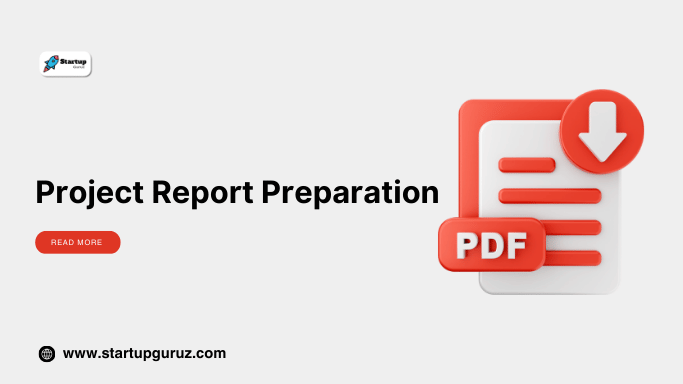Project Report Preparation
Project Report Preparation: A Comprehensive Guide
Introduction
A Project Report is a critical document required for business planning, financial assistance, and project execution. Whether you’re applying for a bank loan, government scheme, or investor funding, a well-structured project report helps present your business plan, financial projections, and growth potential in an organized manner.
This guide will walk you through the importance of a project report, its components, step-by-step preparation, and FAQs to help you create an effective and professional project report.

What is a Project Report?
A Project Report is a detailed document that provides information about a business idea, financial requirements, expected outcomes, and risk assessment.
It includes:
✔ Project description and objectives
✔ Market analysis and feasibility study
✔ Financial projections and funding needs
✔ Operational and risk management strategies
A well-prepared project report acts as a blueprint for the successful execution of a business project.
Importance of a Project Report
✔ Helps secure funding from banks, investors, and financial institutions
✔ Provides a structured roadmap for project implementation
✔ Identifies market opportunities and competition analysis
✔ Ensures proper resource allocation and risk management
✔ Aids in legal and regulatory approvals
Key Components of a Project Report
1. Executive Summary
- Overview of the project
- Objectives and business goals
- Key financial highlights
2. Project Description
- Business concept and structure
- Scope of the project
- Target audience and market potential
3. Market & Industry Analysis
- Market demand and trends
- Competition analysis
- Growth opportunities
4. Organizational Structure
- Ownership and management team
- Roles and responsibilities
5. Financial Projections
- Estimated revenue
- Expenses and operational costs
- Profit & Loss forecast
6. Investment & Funding Requirements
- Total capital required
- Sources of funding (equity, loans, grants)
7. Loan Repayment Plan
- Loan tenure and interest rate
- Monthly or annual EMI schedule
8. Risk Analysis & Mitigation Strategies
- Financial risks
- Market and operational risks
- Contingency plans
9. Legal & Compliance Requirements
- Licenses and permits needed
- Taxation and regulatory approvals
10. Conclusion & Recommendations
- Summary of financial feasibility
- Next steps for project execution
How to Prepare a Project Report?
Step 1: Define the Project Scope & Goals
Clearly outline business objectives, expected outcomes, and market scope.
Step 2: Conduct Market Research
Analyze industry trends, market demand, and competitor strategies.
Step 3: Prepare Financial Projections
Estimate investment needs, expected revenue, and cost structure.
Step 4: Identify Funding Sources
List available funding options, loan details, and investor opportunities.
Step 5: Structure the Report Properly
Use clear sections, headings, tables, and charts for easy understanding.
Step 6: Review & Finalize
Ensure accuracy in financial calculations, grammar, and overall presentation.
Sample Project Report (Example)
Project Name: Organic Farming Business
Prepared By: XYZ Agri Solutions
Submission Date: March 2025
Executive Summary
XYZ Agri Solutions aims to establish a 50-acre organic farm to supply fresh vegetables and fruits to retail stores and supermarkets.
Market Analysis
- Organic food market is growing at 20% annually.
- Consumers are willing to pay a premium for chemical-free produce.
Financial Overview
- Total Investment Required: ₹1 Crore
- Loan Applied: ₹75 Lakh
- Expected Revenue: ₹30 Lakh annually
Loan Repayment Plan
- Interest Rate: 7% per annum
- Loan Tenure: 7 years
- EMI: ₹1 Lakh per month
Risk Assessment & Mitigation
- Risk: Seasonal crop failures
- Solution: Diversify crops and invest in greenhouse technology
Conclusion
The project is financially viable, has low risks, and aligns with consumer demand for organic products.
Best Practices for Writing a Project Report
✔ Use a professional format with headings and subheadings
✔ Ensure accurate and realistic financial data
✔ Include charts, graphs, and tables for better understanding
✔ Keep language simple and easy to read
✔ Customize the report for different funding institutions
Frequently Asked Questions (FAQs)
1. What is the purpose of a project report?
A project report is prepared to secure funding, present financial feasibility, and create a roadmap for project execution.
2. How long should a project report be?
It varies based on project complexity, but an ideal project report should be 15-30 pages.
3. Can I prepare a project report on my own?
Yes, you can use templates, financial tools, and business reports to draft your own. However, professional help is recommended for accuracy.
4. What are the common mistakes in project report preparation?
- Unrealistic financial projections
- Lack of market research
- Missing risk analysis and mitigation strategies
5. Which industries require project reports?
Industries like manufacturing, agriculture, real estate, retail, healthcare, and IT startups require project reports for funding and approvals.
6. What software can I use to prepare a project report?
You can use MS Excel, Google Sheets, Tally, QuickBooks, or specialized financial modeling tools.
7. What details should be included in the financial section?
The financial section should include capital requirements, revenue projections, cost estimation, and loan repayment schedules.
8. Can project reports be used for government schemes?
Yes, project reports are required for PMEGP, MSME, NABARD, Mudra loans, and startup funding schemes.
9. How can I make my project report more attractive to investors?
- Highlight profitability and ROI
- Show detailed market research
- Present clear risk management strategies
10. Where can I find sample project reports?
You can download sample reports from government websites, financial institutions, and business consulting firms.